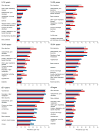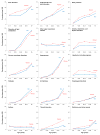Why patients visit their doctors: assessing the most prevalent conditions in a defined American population
- PMID: 23274019
- PMCID: PMC3564521
- DOI: 10.1016/j.mayocp.2012.08.020
Why patients visit their doctors: assessing the most prevalent conditions in a defined American population
Abstract
Objective: To describe the prevalence of nonacute conditions among patients seeking health care in a defined US population, emphasizing age, sex, and ethnic differences.
Patients and methods: The Rochester Epidemiology Project (REP) medical records linkage system was used to identify all residents of Olmsted County, Minnesota, on April 1, 2009, who had consented to review of their medical records for research (142,377 patients). We then electronically extracted all International Classification of Diseases, Ninth Revision codes noted in the records of these patients by any health care institution between January 1, 2005, and December 31, 2009. We grouped International Classification of Diseases, Ninth Revision codes into clinical classification codes and then into 47 broader disease groups associated with health-related quality of life. Age- and sex-specific prevalence was estimated by dividing the number of individuals within each group by the corresponding age- and sex-specific population. Patients within a group who had multiple codes were counted only once.
Results: We included a total of 142,377 patients, 75,512 (53%) of whom were female. Skin disorders (42.7%), osteoarthritis and joint disorders (33.6%), back problems (23.9%), disorders of lipid metabolism (22.4%), and upper respiratory tract disease (22.1%, excluding asthma) were the most prevalent disease groups in this population. Ten of the 15 most prevalent disease groups were more common in women in almost all age groups, whereas disorders of lipid metabolism, hypertension, and diabetes were more common in men. Additionally, the prevalence of 7 of the 10 most common groups increased with advancing age. Prevalence also varied across ethnic groups (whites, blacks, and Asians).
Conclusion: Our findings suggest areas for focused research that may lead to better health care delivery and improved population health.
Copyright © 2013 Mayo Foundation for Medical Education and Research. Published by Elsevier Inc. All rights reserved.
Conflict of interest statement
Conflict of Interest/Financial Disclosures: The authors have no conflict of interest or financial disclosures to report.
Figures



Comment in
-
Prevalence of skin disorders in patients seeking health care.Mayo Clin Proc. 2013 Jul;88(7):776. doi: 10.1016/j.mayocp.2013.05.006. Epub 2013 Jun 7. Mayo Clin Proc. 2013. PMID: 23751981 No abstract available.
-
In reply--Prevalence of skin disorders in patients seeking health care.Mayo Clin Proc. 2013 Jul;88(7):776-7. doi: 10.1016/j.mayocp.2013.05.007. Epub 2013 Jun 7. Mayo Clin Proc. 2013. PMID: 23751982 No abstract available.
-
Psychological mislabelling in chronic pain: reducing the risk.Br J Gen Pract. 2019 Dec 26;70(690):25. doi: 10.3399/bjgp20X707525. Print 2020 Jan. Br J Gen Pract. 2019. PMID: 31879299 Free PMC article. No abstract available.
References
-
- Hwang W, Weller W, Ireys H, et al. Out-of-pocket medical spending for care of chronic conditions. Health Aff (Millwood) 2001;20:267–278. - PubMed
-
- Naessens JM, Stroebel RJ, Finnie DM, et al. Effect of multiple chronic conditions among working-age adults. Am J Manag Care. 2011;17:118–122. - PubMed
-
- Hussey PS, Ridgely MS, Rosenthal MB. The PROMETHEUS bundled payment experiment: slow start shows problems in implementing new payment models. Health Aff (Millwood) 2011;30:2116–2124. - PubMed
Publication types
MeSH terms
Grants and funding
LinkOut - more resources
Full Text Sources
Other Literature Sources
Medical
Miscellaneous

